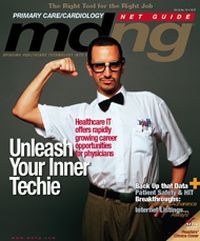Publication
Article
MDNG Primary Care
Special Article: ePrescribing Is Here... and It's Here to Stay
It is here and it is now. It has been covered in every medical and medically related publication imaginable. Electronic prescriping--along with adoption of electronic health records (EHRs)--is one...
It is here and it is now. It has been covered in every medical and medically related publication imaginable. Electronic prescribing— along with adoption of electronic health records (EHRs)—is one of the key technological drivers of healthcare, and it remains a hot-button issue with clear divisions between those who swear by it and those who are reluctant to dip a toe in the water.
All 50 states have now legalized ePrescribing, making it available nationwide. So what do patients and healthcare providers stand to gain by incorporating this technology into regular practice? Glad you asked. For starters, many organizations have identified ePrescribing as a solution for medication and prescription errors. Many ePrescribing programs can identify and alert the prescriber to potentially negative drug interactions and formulary conflicts. As part of the overall EHR, ePrescribing can improve the record-keeping aspect of patients’ medication histories. Illegible, handwritten prescriptions would no longer be the basis of malpractice litigation. This past summer, the Gorman Health Group estimated that ePrescribing could save the federal government up to $29 billion dollars, mostly due to decreases in prescribing errors and increases in the prescribing rates of cheaper generic drugs. The same report estimated that 1.6 to 1.9 million adverse drug events could be avoided with fuller adoption of ePrescribing.
Universal acceptance of ePrescribing, however, does present several challenges. The major issue is who is going to pay for it. The initial outlay for hardware and software isn’t cheap. Training is also an issue, and loss of productivity may occur as physicians and their staff climb the learning curve. Many physicians and group practices are paying for their systems out of pocket, or as part of the overall conversion to an EHR. There are alternatives, such as The National ePrescribing Patient Safety Initiative, that present doctors with a less expensive means of adopting ePrescribing by essentially providing it for free. The federal government is also looking at ways of providing price breaks for physicians who convert to an EHR or use ePrescribing. Interpretations of current Stark self-referral laws appear to pave the way for hospitals to provide computerized medical records and ePrescribing software at little or no cost. Additionally, hospitals and health systems are now launching programs that provide ePrescribing and EHR systems to their staff and affi liated physicians.
It is no surprise that there is still some resistance to this technological trend, and some physicians remain unconvinced that ePrescribing is worth the cost and learning curve involved. But all of these obstacles will prove to be scalable. Now is the time for physicians to look at where they stand in the ePrescribing world, and to make ready for the day when paper prescriptions join Latin as a relic of the medical past. This movement will be driven by government and the private sector, especially the big insurance payers and employers. This has left many doctors wondering what to do, especially those in solo to small practices.
But a wait-and-see strategy may not be the best option. ePrescribing is not just for physician geeks and early adopters. This technology will affect all sectors of medicine, from large multi-state health systems to rural solo practices. It is inherent on the third-party payers, including the federal government, to give tax breaks or payment incentives to propel ePrescribing into general use. Software creators must also make the technology easier to use and provide adequate education and support to doctors adopting their systems. Physicians need to be proactive now, by evaluating their practices’ work flow and researching what type of EHR/ePrescribing system will best work for their practice. Once they choose a vendor, they need to devote whatever time it takes to learn how to use their system, and then evaluate how it impacts work fl ow. Old work habits that worked well for paper generally need to be overhauled to adapt to the medical digital world, and doctors need to understand that this is not necessarily a bad thing. It’s far too late in the game to complain that ePrescribing doesn’t work or that it is too hard to use.
The future is here and now. Th e best advice for physicians is to read all the publications available, research, and shop carefully. Those who plan and implement now will be rewarded for their eff orts. ePrescribing may not be “so easy even a caveman can use it,” but, like the caveman, we must adapt to new tools or run the risk of being eaten.
John Ellison, DO, practices family medicine at the Holzer Clinic in Gallipolis, OH.






